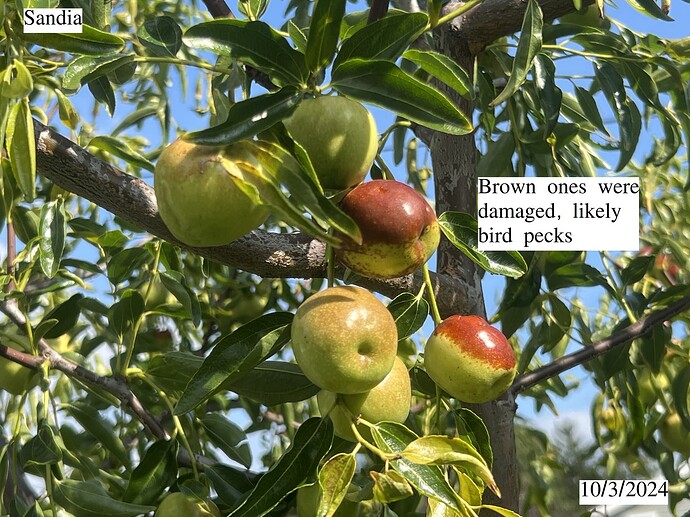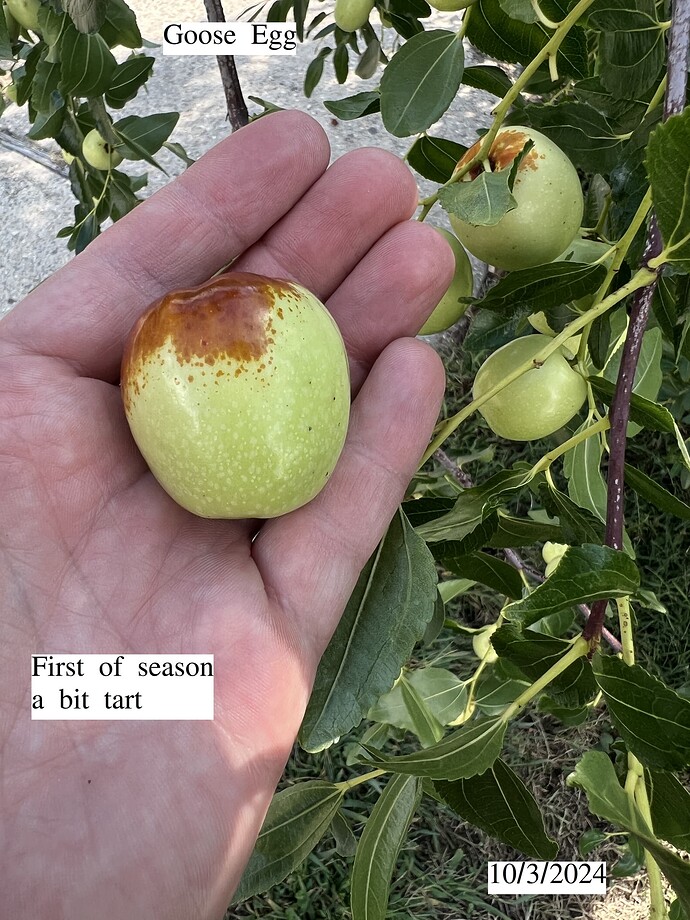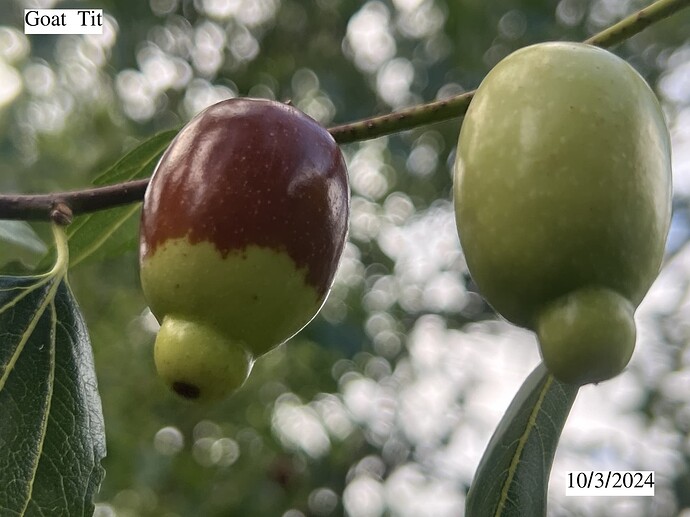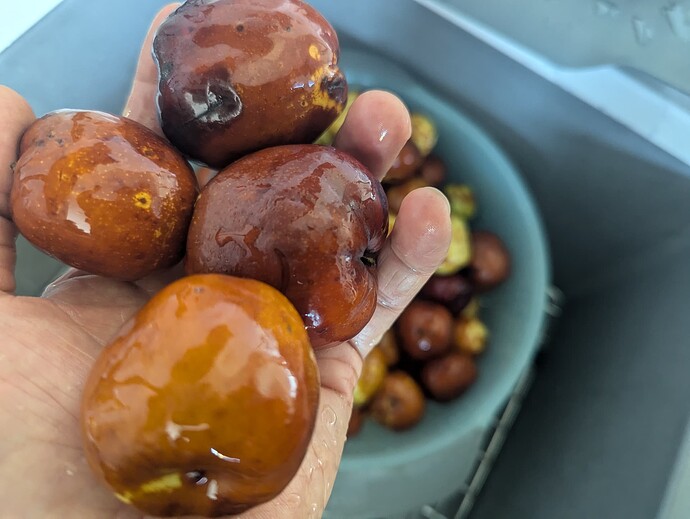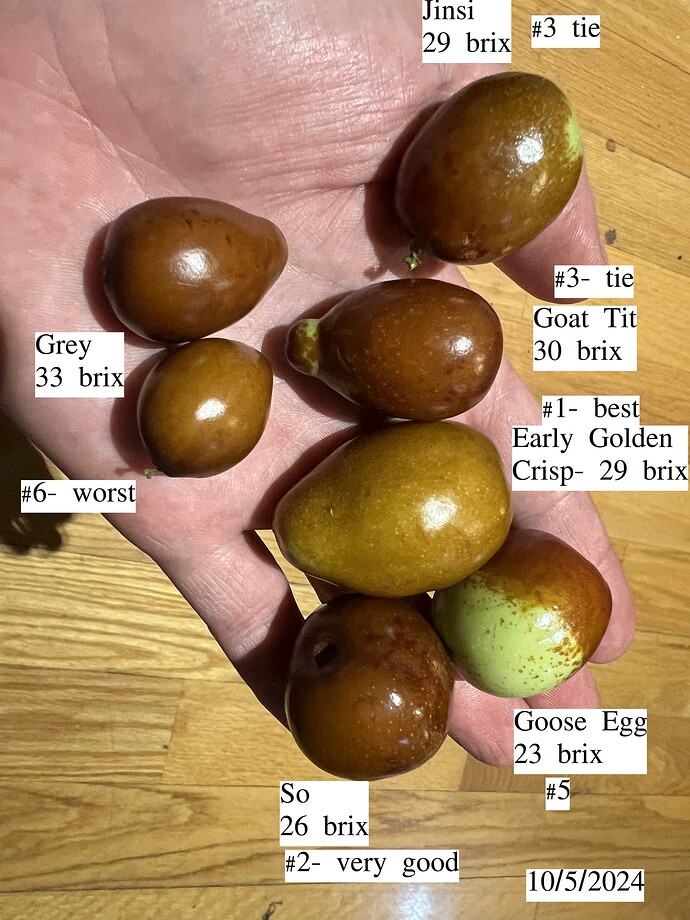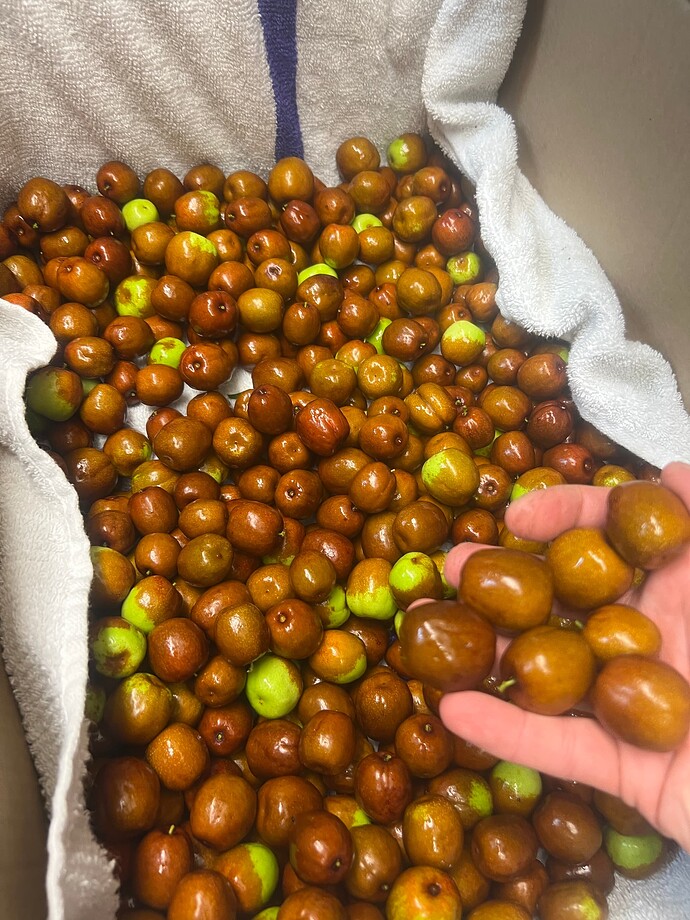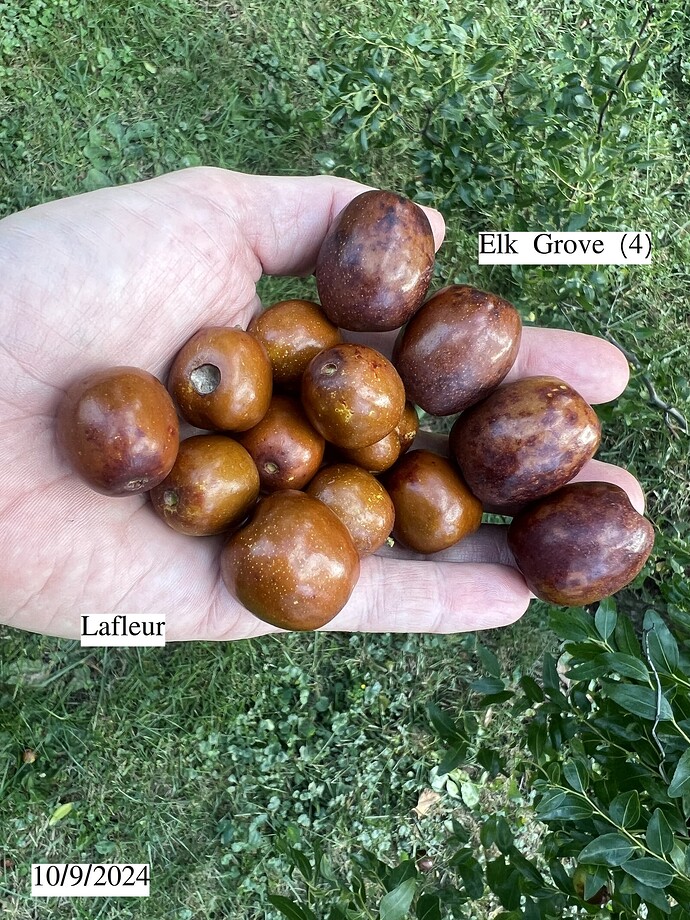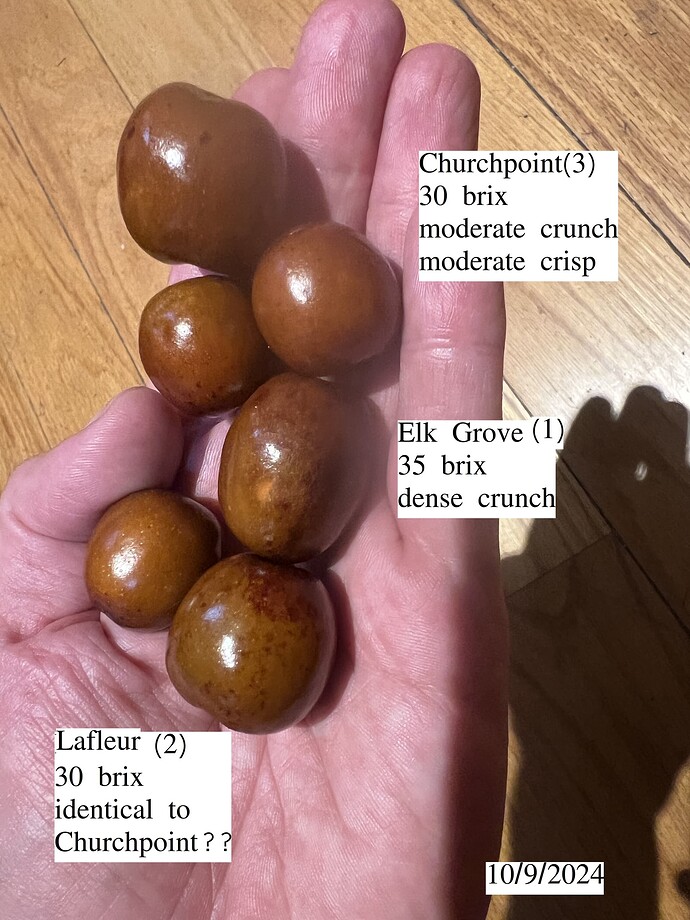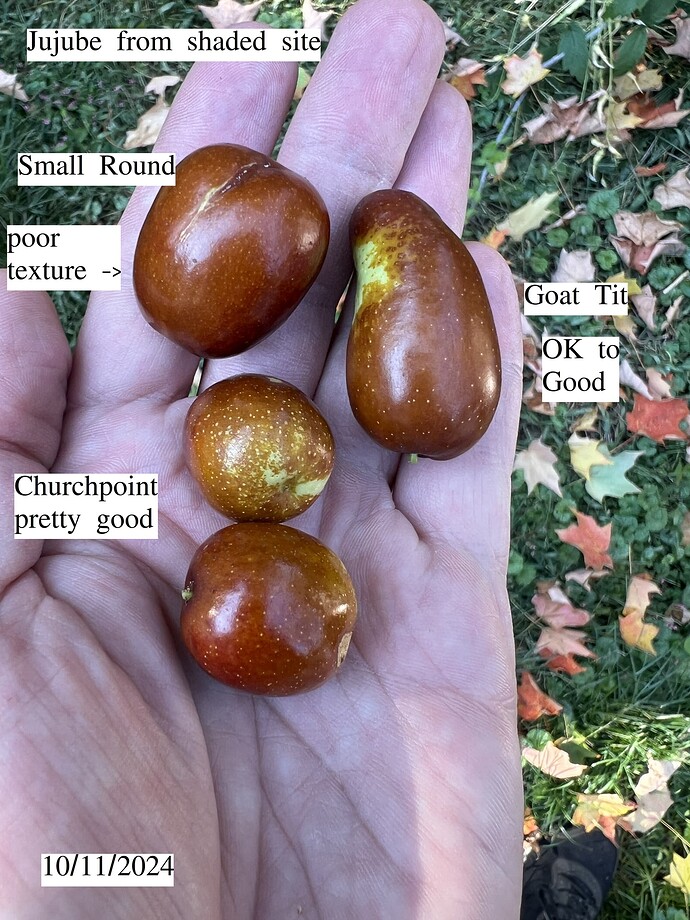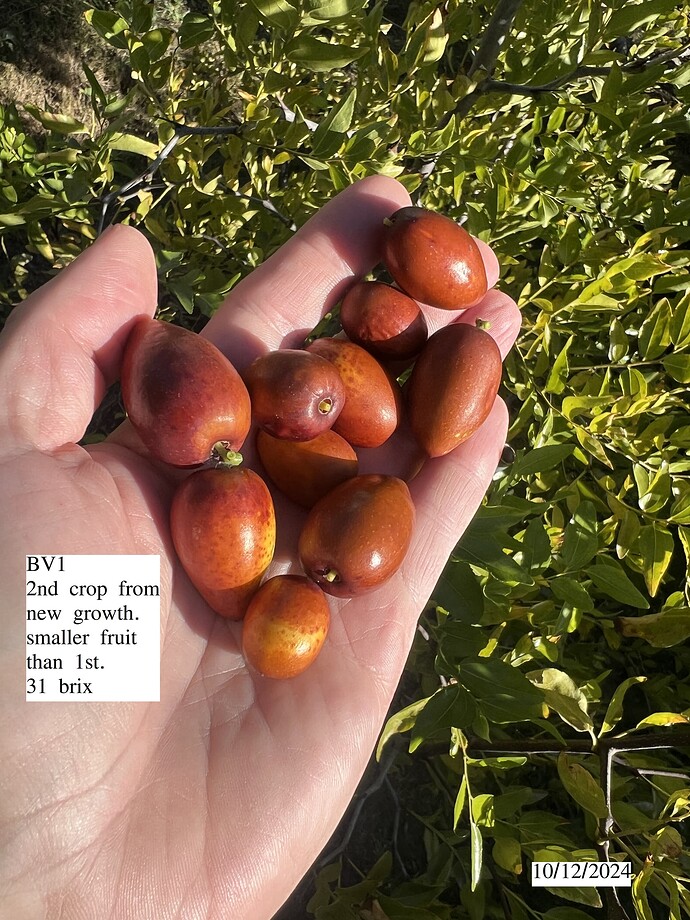Thank you, that makes a lot of sense.
The one I had that she said was July was crisp, but low density. It was very good, but I imagine the texture would degrade faster than denser fruit.
I prefer hard apples to crisp and light, for instance.
Thanks for the comments.
Is it called Autumn Beauty because of the foliage? I just assumed that autumn in the name means late ripening but it is described as early ripening which is probably good for me if I don’t get enough heat.
So you prefer an Arkansas Black or Fuji texture vs a Zestar?
In jujube terms, I think Sugar Cane and Black Sea would be a bit on the ligher, crisper side, while Sherwood and So are more on the hard & dense side. Between Sherwood and So I find So to be much better. Not only is there a little acid balance, but is also has more juice and crunchy/breaking hardness, rather than just being tough.
I’ve been eating quite a few So. This year is by far the best quality year, while also being the lowest production year. So, often produces a lot of small, average fruit, to go along with the 5-30% large, good fruit. This year, some of the So didn’t produce at all, but the ones that did made a much higher proportion of good fruit.
Here’s >8 pounds (maybe 1/3 of the fruit) of mostly good fruit from a 13 year old tree.
I checked a tree today and was surprised to see a few brown fruit. But, when I picked them, I found that they were both damaged (bird peck?), likely what drove the premature ripening. None of the other Sandia or Dong was close to ripe.
A few other later fruits are starting to ripen:
Looks like there will be a 2nd crop of Sihong as well (new growth on the same graft/branch):
I actually forgot to taste Goat Tit. I will be sure to correct that the next time I stop by that property.
I want something that will grow and produce here and be sweeter, and preferably better flavored, than the ones that are available at the local Asian markets that I don’t find worth buying.
Honeyjar seemed the best bet for that, although I’m 0/1 on growing it. The first tree lasted 3 or 4 seasons and only grew a few inches.
I had some jujube trees that only grew maybe 6" in 3-4 years. They were at a site with enough sun, but poor soil, which tended to repel water and stay dry. I dug there a couple hours after a rain and only the top 1/2" to 1" was moist. Once I started adding leaf compost and watering heavily a few times each summer, they started putting on quite a bit more growth.
So, compost, fertilizer, watering, and sun.
Honey Jar and Black Sea are both good ones to start with, having great fruit. If you get big trees, but no production, grafting Bok Jo would probably solve the production issue, as it is a fairly extreme outlier in terms of production and precocity. Bok Jo easily beats the poor quality fruit from the market, but isn’t as good as HJ/BS, since it is crunchy and sweet (can get over 30 brix), but not as crisp & juicy.
Ginormous Li jujube from the Asian market. I have to rely on these store bought jujube until my 25 jujube trees go into production in a few more years at my new place.
This one not sure the name. They go by honey Jujube
I got a few Li large seeds and planning to grow them out to see what I will get. Hopefully they will germinate.
I wonder if they are really Li. I’ve never found a seed in my Li and I think Katy only found a few, after cracking a large number.
At least they look relatively dark. I’ve seen them sold 90% yellow.
Here’s a few of the jujube I’ve been picking:
Early Golden Crisp was the far away leader here. To make it a real contest, I’d need to have Honey Jar or Black Sea in the pic. EGC is just so much crispier and juicier than the others in the pic.
So was very good, even with slightly lower brix. It had the most juice of the non-EGC pictured. And the crunch was quite snappy.
Goat Tit and Jinsi were about the same. A good solid jujube Goat Tit has a bit more juice, which Jinsi has a bit more crunch and is a bit hard.
Goose Egg- OK crunch, a bit tart. This is the first year it has produced and this particular fruit is from the 2nd flush of fruit (the first had only 1-2 fruit) and seems a bit smaller than the first batch. I need to let some GE ripen a bit more to see what that does to the flavor.
Grey-- While the brix is high and it has a bit of crunch, the texture is quite dry. It may do OK as a dried jujube (which is what I’ve heard it is often used for), but the size is pretty small, which isn’t ideal for dried jujubes. And it is consistently low in production, at several sites, over several years.
Goat Tit, Jinsi, and Goose Egg are all producing for the first time, so this is a very preliminary look at them.
Grey and Goat Tit both have interesting tips, but you can generally tell them apart since GT’s tip is mostly straight, while Grey’s tip is bent.
I had the perfect cracking storm this year, super dry for many weeks then a massive rain just as they were all ripening. Pretty much ruined the whole crop. I have never had that bad luck before…
Sorry to hear this, Scott. I have had it a few times but not tyo bad this year.
Since I now have a dehydrator, I put those cracked ones in a dehydrator. I grew up eating rehydrated (dried) jujubes in food so I can use it that way or eat them dried.(far less desirable than fresh). If I leave cracked ones on the trees too longs, they get moldy. Need to pick them promptly and dried them.
When you see it coming, get picking ![]() I was picking in the rain for a while on that first rainy day, just to get another ~20 lbs picked. It hadn’t been raining long, so very few had cracked at that point.
I was picking in the rain for a while on that first rainy day, just to get another ~20 lbs picked. It hadn’t been raining long, so very few had cracked at that point.
Honey Jar picked in the rain. They were initially put into paper bags to bring back home and absorb some of the moisture. Then I used the towel before storing them in ziplocks in the fridge.
And if you can pick it the day of, or even the next day, they are still perfectly good to eat. They just won’t store well without dehydrating. But if they crack and stay on the tree they get pretty iffy after a few days.
I wasn’t able to get to everything though. Here are some Black Sea from another site which I got to the next day. There was a ton of cracking, but 90%+ of the fruit was still very good. I just made sure it got eaten first…
One interesting outlier seems to be Bing Tang. I picked almost all of them before it even started raining. But, even though it hadn’t rained in weeks, over half of them were cracked. Most of the cracks didn’t seem to impact the texture, but I bet it would have gotten bad with even a small amount of rain. It’s too bad, as if I had to ran jujubes on just taste and texture, I think I might have it 1st this year. The fruit was excellent- lots of sweet with a bit of bite that made them good to eat a lot of.
I’m into the late season jujubes now. Not Dong, but most others are at least started.
Sherwood set even fewer than last year (more than half the fruit from a large tree totaled 1.3 lbs. And while they look pretty good, they are too dense and dry.
Another late season one which is ripening is Xu Zhou. This one is generally pretty poor for a number of reasons: Texture, cracking, low-brix, etc. But, this year, one of my 2 Xu Zhou trees did very well- large fruit which ripened without too many cracks. So far, I picked ~9 lbs of uncracked and only a few more pounds of cracked fruit, with most of the cracks not that bad. Of course, it could just be a one-off, given that my other Xu Zhou tree (at a different site) is badly cracked, 80% or more.
This one branch-let had 4 good sized fruit on it. And while the fruit quality isn’t anything like Honey Jar or Black sea, it isn’t too bad, which is a step up from last year. This year it is probably on par with Bok Jo.
I found both Elk Grove and LaFleur ripe at a rental today.
But, when I sampled LaFleur, I was struck by how similar it is to Churchpoint. Texture, size, and brix all match and they both have a bit of tart to them.
Has anyone here grown both Churchpoint and LaFleur? I know @jujubemulberry and @castanea have at least one them, but I’m not sure if anyone else has tried both…
I have both and yes they are very similar. I had not thought about it
Not a good photo but here is a 30ft Jujube with hundreds of perfect fruit at Albuquerque Zoo.
A fence prevented me from picking one.
Looks like the Li jujube.
Tony
Are you in town for the balloon fiesta?
we had both, but lost our tags. If remember it right i obtained lafleur from Cliff, while the Churchpoint was from @castanea. Never got to try churchpoint(not sure if any of the grafts produced fruit) as got too preoccupied with so many things on the year of grafting and subsequent years, and if it did produce or cotninue to produce we wouldn’t be able to know as we stupidly used nondurable tags(just recetnly started using recycled sheet aluminum after learning painful lesson…)
anyway, lafleur is excellent but produced smallish fruits. It is unique for being quite sweet and also spicy/minty. Foliage tends to be small as well, like some wild-type rootstock
we posted a couple photos of lafleur on our publication adjunct, just need to scroll down alphabetical sequence
The foliage is another trait that LaFleur and Churchpoint share. Today, I noticed that the LaFleur graft on a So (at a rental) looks much greener than the rest of the tree. I went back and found this post from 2021, where I noticed the same thing about a Churchpoint graft on a So at my house.
It doesn’t prove that they are the same- though maybe it is evidence that they are at least related in some way, even if it is the class of jujube (eg wild-type).
I checked Prof Yao’s Genetic paper and it has Churchpoint, but not LaFleur, so no help from that perspective.
I picked another jujube for the first time today, Cliff’s Big Sour, the two middle fruit in this pic. This one is the 2nd tartest jujube I’ve had. Texas Tart has it beaten on that front. But, while I can only eat a few of the eye-wateringly sour Texas Tart, I think I would be fine with more of CBS. Similar to TT, the texture isn’t ideal. It may be a bit crunchier, though I think it is a bit drier as well. Size is about the same as Honey Jar, so slightly bigger than Texas Tart. So Cliff’s Big Sour is big for a wild jujube, but on the small end for most cultivars.
One thing that is big for CBS is the pit. Here are the two pits next to half a Honey Jar. I saved them for later planting. It wouldn’t surprise me if each pit had two seeds (as Texas Tart often does as well), given the size of the pit.
Here’s a pic of one way I keep the size of my trees down. When they get tall enough that I can’t reach the fruit from a 8’ ladder, I cut it where I can reach and pick the fruit from the ground. I had my dad (who was picking some jujubes) take the pic of me with the branch, before I picked 1.3 pounds of fruit (plus a few seconds) off it.
Note that I picked a lot from this Sugar Cane tree 3-4 weeks ago. This branch was new growth, with a 2nd flush of fruit.
great pics and updates @BobVance, thanks for sharing as always!
same findings here, and lafleur fruits also tend have a glossy green granny smith hue before tanning up
Visiting relatives but did see many one morning from a distance.
Some more pics:
The most shaded site produced a wider variety this year. Not too many of anything but Honey Jar, but there were a decent amount of KFC, Sugar Cane, and a few Black Sea, Fuicuimi, Churchpoint, and a few others.
The texture of this Small Round was poor, as were the ones I picked from at my house. It isn’t even really round, though it is relatively small.
This Goat Tit had a bit different of a shape from the ones I picked at a better site. The fruit quality from both sites wasn’t bad, but not a standout winner.
I’ve been picking quite a few So. Most of the early varieties are long past and So is just wrapping up now. I picked the last 5 lbs from the big tree at my house yesterday and there isn’t much left on the tree. Quality is quite good this year. Far above the average levels in the past. Maybe not quite as good as the best ones ever, which were into the low 30’s brix. But these are 25 brix, large (for a So), crunchy, and have a bit of tart to them.
The BV1 seedling produced a 2nd flush of fruit on the new growth. Smaller than the first flush, but surprisingly high brix at 31.

